Injection test - effects of injection through a cartridge on the imaging quality of IOLs
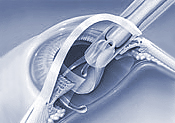
In order to minimize the consequences of the medical procedure for implanting an artificial intraocular lens (IOL), thin, flexible and therefore foldable IOLs are increasingly being implanted.
These can be rolled or folded for the actual implantation and thus implanted through incisions with a width of 2 to 3 mm. In this way, the healing process is significantly shortened compared to the classic surgical technique with non-foldable IOLs. In addition, the risk of changes to the optical properties of the rest of the eye due to the effects of the operation itself is minimized.
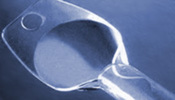
For this minimally invasive surgical technique, IOLs are folded and injected into the anterior chamber through a cartridge (see diagrams above). As the inner diameter of these cartridges is often significantly smaller than the folded cross-section of the IOL to be injected, considerable material stresses sometimes occur during the injection process.
The results of a comparative study investigating the long-term influence of the injection process on the imaging quality of the IOL are presented below.
Test procedure
All tested IOLs were tested with two different refractive powers, +13dpt. and +26dpt. (or the closest value of the product spectrum of the respective IOL type). As already explained in the chapter on image quality and the design differences of IOLs, classic designs do not exhibit any significant spherical aberrations in theory up to a refractive power of approx. 15dpt. At a refractive power of over 25dpt, however, these increase significantly. The two refractive powers selected are therefore well suited to determining the effect of spherical aberrations, the most pronounced imaging error of IOLs.

All measurements consist of two steps. All measurements are carried out on a measuring stand specially developed by the Institute in accordance with the international industry standard EN/ISO 11979-2 [ISO11979] for testing the imaging quality of IOLs. The IOLs to be tested are operated in an artificial eye with a water bath and an effective aperture diameter of 3 mm on the IOL. In order to eliminate possible mechanical tension when fixing the IOL in the water bath, individual measurements are taken until the imaging quality has stabilized at a stable value and the IOL is therefore in a relaxed state with optimal imaging properties.
First, the imaging quality of the unfolded IOL is determined. (The corresponding individual results can be found sorted by design type under"Summary of measurement results").
The actual injection test is then carried out. For this purpose, all IOLs were injected separately through the cartridge recommended by the respective manufacturer. The procedures, injectors, cartridges and viscoelastics recommended by the respective manufacturer were always used. After the actual injection, the image quality was measured in the described setup at intervals of approx. 5 minutes up to a maximum duration of 40 minutes until the original image quality of the IOL, as determined in the first step of the measurement, was achieved again.
Based on these individual measurements, both the Strehl ratio (SR) and the ISO criterion (modulation at 100 line pairs/mm) were determined. These results are listed in the following section.
Results
List of the IOLs examined:
| Manufacturer | IOL type | Measured refractive power |
| *Acri.Tec | *Acri.Smart 46S | +13dpt., +26dpt. |
| *Acri.Tec | *Acri.Smart 36A | +13dpt., +26dpt. |
| AcriMed | 42CSE | +13dpt., +26dpt. |
| Alcon | SA60AT | +13dpt., +26dpt. |
| AMO | AR40e | +13dpt., +26dpt. |
| Bausch & Lomb | Akreos Adapt | +13dpt., +26dpt. |
| Pharmacia | Tecnis Z9000 | +13dpt., +26dpt. |
| Polytech (HOYA) | AF-1 (UV) VA-60BB | +13dpt., +26dpt. |
| ThinOptiX | Ultra Choice PHC001 | +15dpt., +25dpt. |
Measurement results for IOLs with a refractive power of +13dpt:
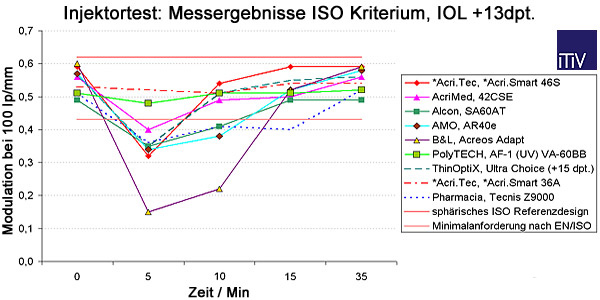
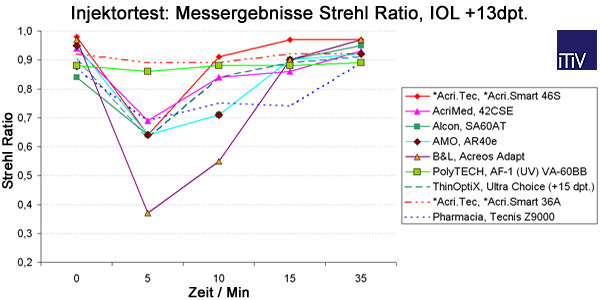
Measurement results for IOLs with a refractive power of +26dpt:
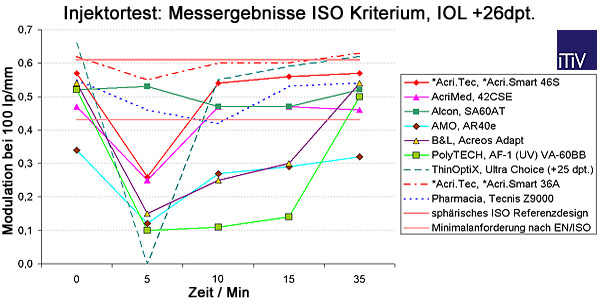
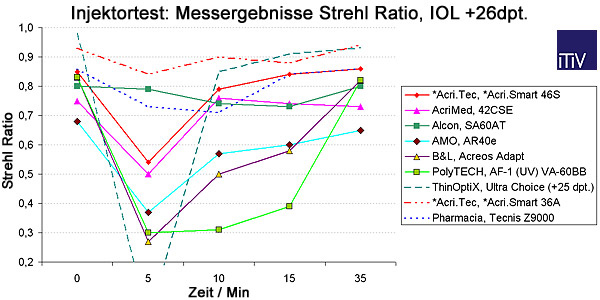
Explanation of the measurement results
All individual measurement results are summarized in the graphs above. The Strehl ratio (image quality compared to the diffraction-limited ideal lens) and the ISO criterion (modulation at 100 line pairs/mm) are shown for each IOL type and each refractive power. In addition, the corresponding value of the symmetrical spherical ISO reference design (upper red line) and the minimum value prescribed for symmetrical spherical designs (lower red line) are also shown in the graphs for the ISO criterion.
Summary
All tested IOLs returned to their original image quality after a maximum duration of 35 minutes. Thus, for the IOLs tested, no permanent impairment of the imaging quality of the IOL due to the injection process can be demonstrated when using the procedures, materials and tools recommended by the respective manufacturer.
Publications
R. Rawer, W. Stork:
Imaging Quality of Intraocular Lenses,
ESCRS, Journal of Cataract and Refractive Surgery, submitted January 2004
Contact Prof.
Prof. Dr. rer.nat. Wilhelm Stork
Tel. 0721 / 608 - 42510, wilhelm.stork∂kit.edu

